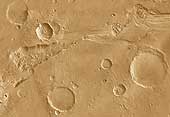|
COMETS EARTH JUPITER KUIPER BELT MARS MERCURY METEORITES NEPTUNE OORT CLOUD PLUTO SATURN SOLAR SYSTEM SPACE SUN URANUS VENUS ORDER PRINTS
PHOTO CATEGORIES SCIENCEVIEWS AMERICAN INDIAN AMPHIBIANS BIRDS BUGS FINE ART FOSSILS THE ISLANDS HISTORICAL PHOTOS MAMMALS OTHER PARKS PLANTS RELIGIOUS REPTILES SCIENCEVIEWS PRINTS
|
Related Document
Download Options
This image of the head of Ravi Vallis shows a 300-kilometer (186-mile) long portion of a channel. Like many other channels that empty into the northern plains of Mars, Ravi Vallis orginates in a region of collapsed and disrupted ("chaotic") terrain within the planet's older, cratered highlands. Structures in these channels indicate that they were carved by liquid water moving at high flow rates. The abrupt beginning of the channel, with no apparent tributaries, suggests that the water was released under great pressure from beneath a confining layer of frozen ground. As this water was released and flowed away, the overlying surface collapsed, producing the disruption and subsidence shown here. Three such regions of chaotic collapsed material are seen in this image, connected by a channel whose floor was scoured by the flowing water. The flow in this channel was from west to east (left to right). This channel ultimately links up with a system of channels that flowed northward into Chryse Basin. (Image Credit: Calvin J. Hamilton; Caption: LPI) This image is Copyright © by Calvin J. Hamilton. Any commercial/for-profit use of this image needs to be addressed to Calvin J. Hamilton. |
||||||||||||||||||||||||
